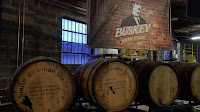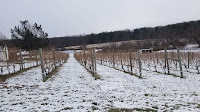 CiderCon 2022
CiderCon 2022 provided Richmond cideries a tremendous platform to showcase their ciders during several after-hour events. Augmenting the River City's vibrant craft beer scene are three cideries,
Buskey Cider and
Blue Bee Cider (located in the popular Scotts Addition neighborhood) and
Bryant's Small Batch Cider -- situated just south of the State Capitol. A few weeks ago I was able to visit
Bryant's primary orchard tasting room in Nelson County and gained an appreciation of that operation. However, the first night of the conference was my first visit to both Scotts Addition cideries.
Buskey Cider

Buskey seemed to be the center of attention at CiderCon hosting tasting events on consecutive nights. They started by pouring cider from almost a dozen other Virginia cideries including
Albemarle CiderWorks and
Old Town Cider. This Winchester cidery's dry Albemarle Pippin cider is excellent and its sharp dry finish was very similar to Buskey's dry cider. Both are very worthy everyday refreshing ciders. CiderCon also allowed me to meet a few orchard growers who tutored me on the intricacies of the Black Twig apple which led to a more interesting tasting.
On the second night, I participated in a seminar presenting Buskey's barrel program. This session consisted of a sampling of five barrel-finished ciders, all but one currently bottled. These ciders all started from Nelson County apples which were fermented dry then placed in different barrels they purchased through a broker. One of these was a
Gin barrel and this imparts several botanicals into the cider's aroma leaving citrus and some coconut on the finish. The
Brandy barrel overwhelmed the cider with too much apple fruit and was the least favorite. The
Mezcal barrel imparted an abundant amount of smokiness, but in an enjoyable amount, which elevated this as one of my favorites. The
Sherry was also appreciated because of the nuts and dried fig and raisin flavors that the cider absorbed. Finally, we were served their
Scotch cider, straight from the holding tank and peat was everywhere. This was a fascinating tasting both from the ciders and the opportunity to talk to the Buskey personnel and other attending cider makers.
 Blue Bee Cider
Blue Bee Cider
After apprenticing at
Albemarle CiderWorks, Courtney Mailey headed to the city to open her own cider operation and plant an urban orchard. From that orchard and another in Nelson County, she creates some of the most delicious ciders in the Commonwealth. Many of these are single varietal ciders that you can sample through a
Manchester flight. This penta-flight starts with the
Harrison, a colonial-era cider apple from the northeast where the full-body, tannic, and abundant acids match the tasting sheet. The
Hewe's Crab follows and this was the most common fruit variety grown in eighteenth-century Virginia. It is thought to be a cross between the native American crabapple, Malus angustifolia, and a domesticated European apple. The funkiest of the group was the
Spitzenburg, discovered in the late 1700s by an early Dutch settler of that name. It was found at the settlement of Esopus, on the Hudson River, in Ulster County, New York. Lots of sweet and tart flavors but also some funk. The English
Dabinett cider apple was the most interesting of these single varietals. The aroma is pure apple, like biting a kid's packaged lunch apples. However, the flavor is bittersweet and tart. The final cider was the
Golden Russet, a cider apple that arose in upstate New York in the 19th century, possibly derived from an English russet variety. This cider showed a nice balance between tannins and acidity.

On a return trip, I had a glass of their
Aragon 1904 which is one of Blue Bee's original ciders. This off-dry cider is made from a blend of modern and heirloom apples and is full of flavor, slightly tart - nice acids.
Bryant's Small Batch Cider
As much as I love Bryants'Brite Good dry brut cider, I used this visit to taste some of their flavored ciders. For the conference, they made sure they had on tap a Banana Bread cider that tasted as advertised. Not over the top, but noticeable walnuts and banana. I also went with a Coffee Chai cider for a little caffeine boost. The tea strongly presented itself and adversely overwhelmed the coffee. I definitely preferred the version I sampled at their Nelson County barn. The Richmond taproom has another difference from the barn. With the paintings and other art, you feel like you are tasting in a Victorian parlor as opposed to a 1900s barn.















